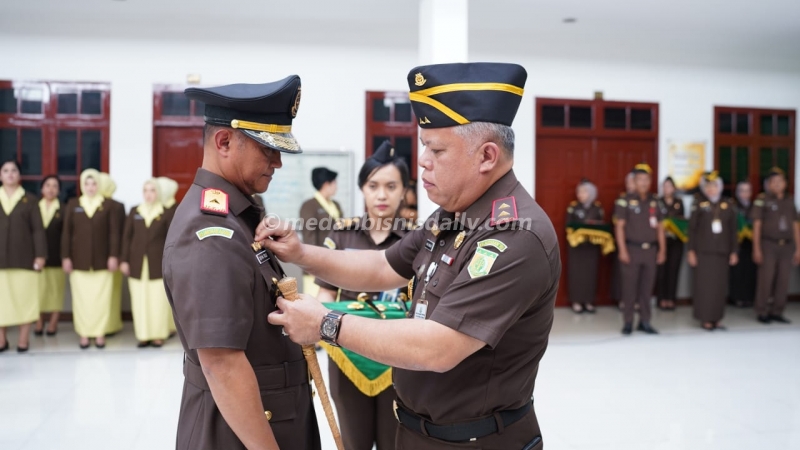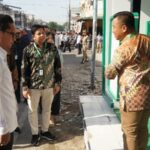The Head Prosecutor of North Sumatra (Kajati Sumut), Dr. Harli Siregar SH M.Hum, inaugurated and administered the oath of office for the Deputy Head Prosecutor (Wakajati), two Assistants, and eight District Chief Prosecutors (Kajari) at the Adhyaksa Hall, Jalan Jenderal Besar AH Nasution, Medan.
In his speech, Harli Siregar welcomed the newly appointed officials and expressed gratitude to the outgoing officials.
“I extend my highest appreciation and thanks to the outgoing officials for their dedication and service,” he stated.
Harli instructed the newly appointed officials to promptly identify their regional duties and work efficiently to advance the Prosecutor’s Office while addressing the legal needs of the community.
“A position is a form of institutional trust and a mandate that must be carried out, measured by performance results, which will be evaluated later,” Harli emphasized.
He urged the new officials within the North Sumatra High Prosecutor’s Office to internalize that their duties and responsibilities are a calling from the heart.
“This way, in carrying out their duties, they can provide benefits to society, particularly in enforcing humane and just law,” he explained.
The inauguration and handover of positions were based on the Attorney General’s Decree No. 352 and 353 of 2025, dated July 4, 2025.
The appointed officials include Sofyan Selle SH MH as Deputy Head Prosecutor of North Sumatra, replacing Rudi Irmawan SH MH, who was promoted to Director of Legal Considerations at the Attorney General’s Office. Sofyan previously served as Deputy Head Prosecutor of Gorontalo.
Additionally, Moch Jefry SH MH, formerly Chief Prosecutor of Deli Serdang, was inaugurated as Assistant for Special Crimes (Aspidsus), replacing Muttaqin Harahap SH MH.
Muttaqin Harahap was promoted to Head of the Pre-Prosecution Subdirectorate under Directorate D at the Attorney General’s Office in Jakarta.
Jurist Precisely SH M.Hum was appointed as Assistant for General Crimes (Aspidum), succeeding Imanuel Rudy Pailang, who was promoted to Coordinator at the Attorney General’s Intelligence Division in Jakarta.
Furthermore, eight District Chief Prosecutors (Kajari) were also inaugurated, covering Deli Serdang, Pematangsiantar, Binjai, North Padang Lawas, Labuhan Batu, South Nias, Langkat, and South Labuhanbatu.
“The Head of Administration at the North Sumatra High Prosecutor’s Office and two echelon III officials were also inaugurated as Coordinators,” the statement concluded.
North Sumatra High Prosecutor’s Office
The **North Sumatra High Prosecutor’s Office** is a key legal institution in Medan, Indonesia, responsible for overseeing prosecutorial matters in the region. Established as part of Indonesia’s judicial system, it plays a vital role in upholding law and justice in North Sumatra. Its history reflects the broader development of Indonesia’s legal framework following independence.
Adhyaksa Hall
Adhyaksa Hall, located in Bogor, Indonesia, is a historic building that originally served as the residence of high-ranking Dutch colonial officials during the 19th century. Today, it functions as the office of the West Java High Court, reflecting its continued role in governance. The architecture blends colonial and local influences, showcasing Indonesia’s historical and cultural heritage.
Jalan Jenderal Besar AH Nasution
Jalan Jenderal Besar AH Nasution is a major road in Jakarta, Indonesia, named after General Abdul Haris Nasution, a prominent military leader during Indonesia’s struggle for independence and the Cold War era. The road is historically significant as it connects key areas of Jakarta and has witnessed many important events in the city’s development. Today, it serves as a vital transportation route, lined with commercial and residential buildings, reflecting Jakarta’s urban growth.
Attorney General’s Office
The **Attorney General’s Office** is a key legal institution in many countries, responsible for representing the government in legal matters, advising on law and policy, and overseeing prosecutions. Its history varies by nation, but it often dates back to the establishment of modern legal systems—for example, the U.S. Attorney General’s office was created in 1789 under the Judiciary Act. The role and powers of the office depend on the country’s legal framework, ranging from advisory functions to leading national prosecutions.
Deli Serdang
Deli Serdang is a regency in North Sumatra, Indonesia, historically part of the Deli Sultanate, which flourished as a center of trade and agriculture during the colonial era. Today, it is known for its cultural diversity, blending Malay, Batak, and Javanese influences, and its economic activities, particularly in palm oil and rubber production. The region also features historical landmarks like the Maimun Palace and traditional villages that reflect its rich heritage.
Pematangsiantar
Pematangsiantar, often called Siantar, is a city in North Sumatra, Indonesia, known for its rich cultural diversity and historical significance as a trading hub during the Dutch colonial era. It is home to the Vihara Avalokitesvara, one of the largest Buddhist temples in Indonesia, reflecting the city’s multicultural heritage. The city also serves as a gateway to Lake Toba, a major tourist destination.
Binjai
Binjai is a city in North Sumatra, Indonesia, known for its historical significance as a trading hub during the colonial era. Established in the 19th century, it grew around the Deli River and was influenced by Malay, Javanese, and Dutch cultures. Today, Binjai is recognized for its cultural diversity, traditional markets, and proximity to natural attractions like Gunung Leuser National Park.
North Padang Lawas
North Padang Lawas is a regency in North Sumatra, Indonesia, known for its rich historical and cultural heritage, particularly its ancient Hindu-Buddhist temples dating back to the 8th–13th centuries. The area was once part of the Panai Kingdom, a significant maritime power linked to the Srivijaya Empire. Key archaeological sites, such as the Bahal Temple complex, showcase intricate stone carvings and reflect the region’s importance as a center of trade and religion in ancient Sumatra.






